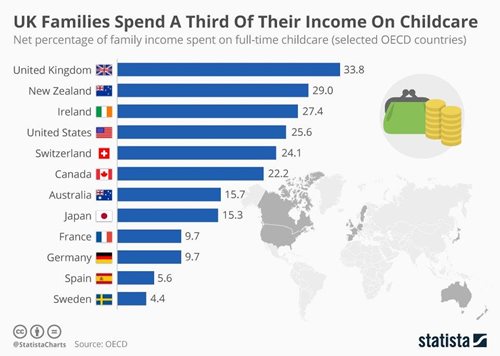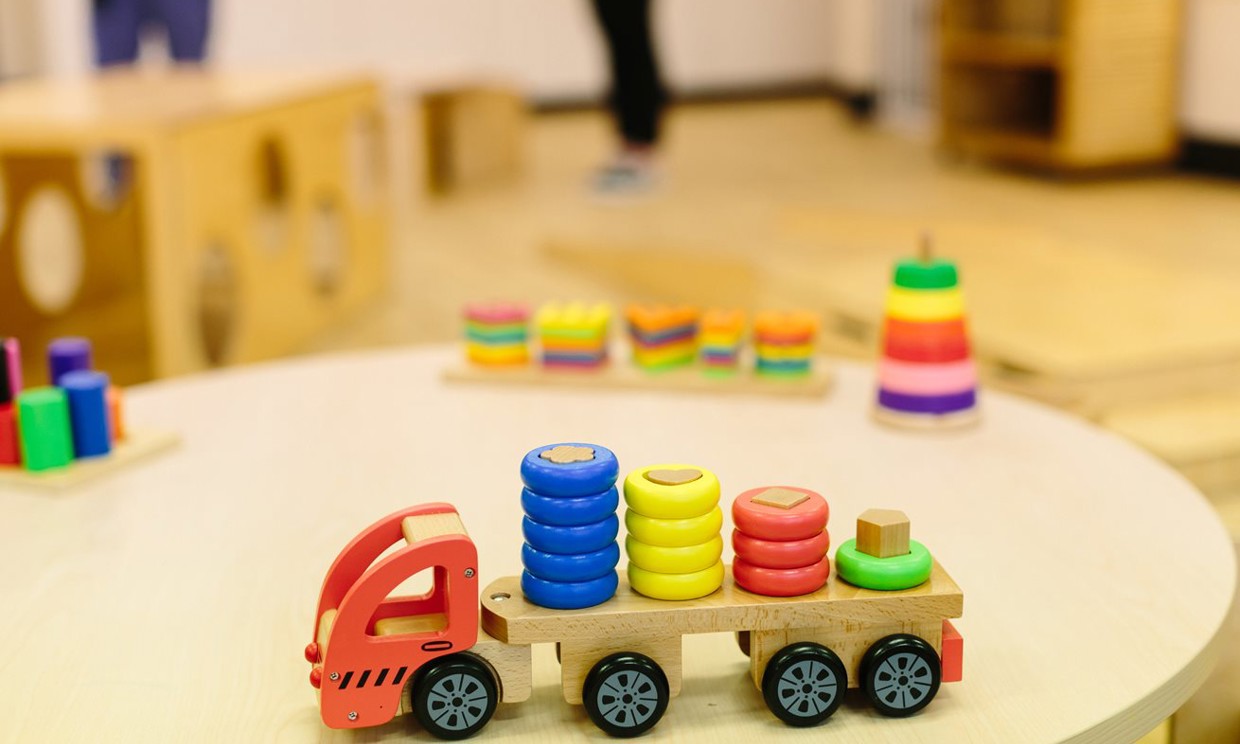The high cost of childcare is one reason Australia sits in the bottom third of developed countries for female employment.
The latest Organisation for Economic Co-operation & Development report, released last week, revealed Australia’s position in the bottom tranche and pointed to childcare costs as a contributing factor.
Unlike Sweden, where child care costs after government subsidies account for 4.4 per cent of a family’s income (before tax), out of pocket early learning costs for Australian families after government subsidies account for around 15.7 per cent of their family income.
The OECD report highlights why Australia should be helping more mothers with young children, Indigenous Australians and older women into work.
Goodstart Early Learning advocacy manager John Cherry said the cost of childcare in Australia had a direct influence on a family’s decision to return to work and the number of hours worked.
Mr Cherry said Australian mothers with children under five years of age have one of the lowest rates of workforce participation in the developed world.
“Yet, report after report shows that many mothers would increase their hours of work if the cost of childcare was not a barrier,” Mr Cherry said.
“The Child Care Package set for debate in the Senate next week could be a game changer for many families, reducing out of pocket child care costs by around $30 a week,” Mr Cherry said.
“The gains will be biggest for families where the second income earner want to work more days as the cap on the Child Care Rebate locks many parents into working 3 days a week or less,” he said.
Independent research by PricewaterhouseCoopers (PwC) and commissioned by Goodstart Early Learning had found that the Federal Government’s childcare package would encourage thousands of parents to return to work or increase their days.
“The Jobs for Families childcare package will deliver a significant economic gain for our nation by making returning to work more attractive for parents,” he said.
“PwC has estimated the childcare package will add the equivalent of nearly 20,000 full time workers to the labour force by 2020, rising to 29,000 by 2050, and adding $3.1 billion to national GDP.”

The OECD report highlights there are big costs to the economy when women stay at home or work short part-time hours.
Goldman Sachs has estimated that if Australia lifted its female participation rate closer to that of males it could bring economic benefits equivalent to 11 per cent of gross domestic product.
Despite female workplace participation lagging behind men, according to OECD, young Australian women are better-educated than their male counterparts: in 2014, some 53.7 per cent of 25-34 year-old women had attained tertiary education, compared with 42.5 per cent of men.
“Australia's relatively high childcare costs are one important factor contributing to the high 'not in employment, education or training' rates among young mothers with young children," the OECD group said.
Why our children’s future will reap from greater workforce participation
Mr Cherry said on top of the economic benefits there was a multitude of social benefits associated with parents returning to work and higher levels of education for children.
Research shows when children have access to quality early childhood education they can expect better school success, a decreased crime rate, less substance abuse and increased long-term employment.
Mr Cherry said the latest OECD report shows how our country was missing out and stressed further efforts were needed to avoid a future shortage of labour as the population ages.
“Past OECD reports have repeatedly called on governments to invest more in early childhood education and child care to improve workforce production and reduce social inequality,” Mr Cherry said.
Another report by OECD, Going for Growth 2016: Australia, stated that boosting productivity required a number of common structural weaknesses be addressed, in particular in the areas of educational outcomes – to ensure that educational qualification translates into skills, starting with the early years.
The performance of high school students in Programme for International Student Assessment (PISA) tests in science and reading proficiency is only around the international average and with a tendency to show a high variation across students. PISA tests have has consistently shown that children who attended early learning enjoy better test results in high school.
“OECD have clearly outlined that improving all levels of education will be crucial to boosting the long-term productive and innovative capacity of the Australian economy,’’ Mr Cherry said.
“Importantly they highlight that reform should be geared towards increasing the supply and quality of early childhood education.”
Find out how you may be affected by the Government's new Childcare Package by using our childcare subsidy estimator.
The latest Organisation for Economic Co-operation & Development report, released last week, revealed Australia’s position in the bottom tranche and pointed to childcare costs as a contributing factor.
Unlike Sweden, where child care costs after government subsidies account for 4.4 per cent of a family’s income (before tax), out of pocket early learning costs for Australian families after government subsidies account for around 15.7 per cent of their family income.
The OECD report highlights why Australia should be helping more mothers with young children, Indigenous Australians and older women into work.
Goodstart Early Learning advocacy manager John Cherry said the cost of childcare in Australia had a direct influence on a family’s decision to return to work and the number of hours worked.
Mr Cherry said Australian mothers with children under five years of age have one of the lowest rates of workforce participation in the developed world.
“Yet, report after report shows that many mothers would increase their hours of work if the cost of childcare was not a barrier,” Mr Cherry said.
Jobs for Families childcare package will boost female workforce participation
“The Child Care Package set for debate in the Senate next week could be a game changer for many families, reducing out of pocket child care costs by around $30 a week,” Mr Cherry said.“The gains will be biggest for families where the second income earner want to work more days as the cap on the Child Care Rebate locks many parents into working 3 days a week or less,” he said.
Independent research by PricewaterhouseCoopers (PwC) and commissioned by Goodstart Early Learning had found that the Federal Government’s childcare package would encourage thousands of parents to return to work or increase their days.
“The Jobs for Families childcare package will deliver a significant economic gain for our nation by making returning to work more attractive for parents,” he said.
“PwC has estimated the childcare package will add the equivalent of nearly 20,000 full time workers to the labour force by 2020, rising to 29,000 by 2050, and adding $3.1 billion to national GDP.”
Female workforce participation brings economic benefits
The OECD report highlights there are big costs to the economy when women stay at home or work short part-time hours. Goldman Sachs has estimated that if Australia lifted its female participation rate closer to that of males it could bring economic benefits equivalent to 11 per cent of gross domestic product.
Despite female workplace participation lagging behind men, according to OECD, young Australian women are better-educated than their male counterparts: in 2014, some 53.7 per cent of 25-34 year-old women had attained tertiary education, compared with 42.5 per cent of men.
“Australia's relatively high childcare costs are one important factor contributing to the high 'not in employment, education or training' rates among young mothers with young children," the OECD group said.
Why our children’s future will reap from greater workforce participation
Mr Cherry said on top of the economic benefits there was a multitude of social benefits associated with parents returning to work and higher levels of education for children.
Research shows when children have access to quality early childhood education they can expect better school success, a decreased crime rate, less substance abuse and increased long-term employment.
Mr Cherry said the latest OECD report shows how our country was missing out and stressed further efforts were needed to avoid a future shortage of labour as the population ages.
“Past OECD reports have repeatedly called on governments to invest more in early childhood education and child care to improve workforce production and reduce social inequality,” Mr Cherry said.
Another report by OECD, Going for Growth 2016: Australia, stated that boosting productivity required a number of common structural weaknesses be addressed, in particular in the areas of educational outcomes – to ensure that educational qualification translates into skills, starting with the early years.
The performance of high school students in Programme for International Student Assessment (PISA) tests in science and reading proficiency is only around the international average and with a tendency to show a high variation across students. PISA tests have has consistently shown that children who attended early learning enjoy better test results in high school.
“OECD have clearly outlined that improving all levels of education will be crucial to boosting the long-term productive and innovative capacity of the Australian economy,’’ Mr Cherry said.
“Importantly they highlight that reform should be geared towards increasing the supply and quality of early childhood education.”
Find out how you may be affected by the Government's new Childcare Package by using our childcare subsidy estimator.


